Thermal Performance Evaluation of a Tubular Heat Exchanger Fitted with Combined Basket–Twisted Tape Inserts
Abstract
:1. Introduction
2. Experimental Apparatus Description
3. Governing Equations
4. Error Analysis and Uncertainties of Experimental Data
5. Results
5.1. Confirmation of the Plain Heat Exchanger Findings
5.2. Impact of Combined Basket–Twisted Tape Inserts
5.3. Thermal Performing Assessment
5.4. Empirical Correlations
6. Conclusions
Author Contributions
Funding
Acknowledgments
Conflicts of Interest
Nomenclature
| Att | Inner Surface Area of tube Test Section, m2 |
| Cp.a | Specific Heat of Air, J/kg.K |
| D | Hydraulic Diameter, m |
| f | Friction Factor |
| Coefficient of Heat Transfer, W/m2.K | |
| I | Current, A |
| V | Voltage, volt |
| Ka | Thermal Conductivity, W/m.K |
| L | Length of Tube Test Section, m |
| a | Air Mass Flow Rate, kg/s |
| N | Number of Turbulators pieces |
| Nud | Average Nusselt Number of Plain tube Case |
| Pr | Prandtl Number |
| Heat losses, W | |
| Convective Heat Transfer from the Test Section, W | |
| Re | Reynolds Number |
| Tb,I | Temperature of Air at the Test Section Entrance, °K |
| Tb,o | Temperature of Air at the Test Section Exit, °K |
References
- Yakut, K.; Sahin, B. Flow-induced vibration analysis of conical rings used for heat transfer enhancement in heat exchangers. Appl. Energy 2004, 78, 273–288. [Google Scholar] [CrossRef]
- Mashayekhi, R.; Khodabandeh, E.; Bahiraei, M.; Bahrami, L.; Toghraie, D.; Akbari, O.A. Application of a novel conical strip insert to improve the efficacy of water–Ag nanofluid for utilization in thermal systems: A two-phase simulation. Energy Convers. Manag. 2017, 151, 573–586. [Google Scholar] [CrossRef]
- Gravndyan, Q.; Akbari, O.A.; Toghraie, D.; Marzban, A.; Mashayekhi, R.; Karimi, R.; Pourfattah, F. The effect of aspect ratios of rib on the heat transfer and laminar water/TiO2 nanofluid flow in a two-dimensional rectangular microchannel. J. Mol. Liq. 2017, 236, 254–265. [Google Scholar] [CrossRef]
- Wahhab, H.A.A.; Al-Maliki, W.A.K. Application of a Solar Chimney Power Plant to Electrical Generation in Covered Agri-cultural Fields. In IOP Conference Series: Materials Science and Engineering; IOP Publishing: Kerbala, Iraq, 2020; p. 012137. [Google Scholar]
- Nouri-Borujerdi, A.; Nakhchi, M. Heat transfer enhancement in annular flow with outer grooved cylinder and rotating inner cylinder: Review and experiments. Appl. Therm. Eng. 2017, 120, 257–268. [Google Scholar] [CrossRef]
- Khoshvaght-Aliabadi, M.; Zangouei, S.; Hormozi, F. Performance of a plate-fin heat exchanger with vortex-generator channels: 3D-CFD simulation and experimental validation. Int. J. Therm. Sci. 2015, 88, 180–192. [Google Scholar] [CrossRef]
- Mamourian, M.; Shirvan, K.M.; Mirzakhanlari, S.; Rahimi, A. Vortex generators position effect on heat transfer and nanofluid homogeneity: A numerical investigation and sensitivity analysis. Appl. Therm. Eng. 2016, 107, 1233–1247. [Google Scholar] [CrossRef]
- Sawhney, J.; Maithani, R.; Chamoli, S. Experimental investigation of heat transfer and friction factor characteristics of solar air heater using wavy delta winglets. Appl. Therm. Eng. 2017, 117, 740–751. [Google Scholar] [CrossRef]
- Al-Maliki, W.A.K.; Al-Khafaji, H.M.H.; Alobaid, F.; Epple, B. Design and Implementation of the Solar Field and Thermal Storage System Controllers for a Parabolic Trough Solar Power Plant. Appl. Sci. 2021, 11, 6155. [Google Scholar] [CrossRef]
- Chamoli, S.; Lu, R.; Xie, J.; Yu, P. Numerical study on flow structure and heat transfer in a circular tube integrated with novel anchor shaped inserts. Appl. Therm. Eng. 2018, 135, 304–324. [Google Scholar] [CrossRef]
- Ibrahim, M.; Essa, M.; Mostafa, N. A computational study of heat transfer analysis for a circular tube with conical ring turbulators. Int. J. Therm. Sci. 2019, 137, 138–160. [Google Scholar] [CrossRef]
- Xu, Y.; Islam, M.; Kharoua, N. Experimental study of thermal performance and flow behaviour with winglet vortex generators in a circular tube. Appl. Therm. Eng. 2018, 135, 257–268. [Google Scholar] [CrossRef]
- Chamoli, S.; Lu, R.; Yu, P. Thermal characteristic of a turbulent flow through a circular tube fitted with perforated vortex generator inserts. Appl. Therm. Eng. 2017, 121, 1117–1134. [Google Scholar] [CrossRef]
- Nakhchi, M.; Esfahani, J. Numerical investigation of different geometrical parameters of perforated conical rings on flow structure and heat transfer in heat exchangers. Appl. Therm. Eng. 2019, 156, 494–505. [Google Scholar] [CrossRef]
- He, Y.; Liu, L.; Li, P.; Ma, L. Experimental study on heat transfer enhancement characteristics of tube with cross hollow twisted. Appl. Therm. Eng. 2018, 131, 743–749. [Google Scholar] [CrossRef]
- Bhuiya, M.; Roshid, M.; Talukder, M.; Rasul, M.; Das, P. Influence of perforated triple twisted tape on thermal performance characteristics of a tube heat exchanger. Appl. Therm. Eng. 2020, 167, 114769. [Google Scholar] [CrossRef]
- Bhuiya, M.; Azad, A.; Chowdhury, M.; Saha, M. Heat transfer augmentation in a circular tube with perforated double counter twisted tape inserts. Int. Commun. Heat Mass Transf. 2016, 74, 18–26. [Google Scholar] [CrossRef]
- Piriyarungrod, N.; Kumar, M.; Thianpong, C.; Pimsarn, M.; Chuwattanakul, V.; Eiamsa-ard, S. Intensification of thermo-hydraulic performance in heat exchanger tube inserted with multiple twisted-tapes. Appl. Therm. Eng. 2018, 136, 516–530. [Google Scholar] [CrossRef]
- Khoshvaght-Aliabadi, M.; Feizabadi, A. Performance intensification of tubular heat exchangers using compound twisted-tape and twisted-tube. Chem. Eng. Process. Process. Intensif. 2020, 148, 107799. [Google Scholar] [CrossRef]
- Salam, B.; Biswas, S.; Saha, S.; Bhuiya, M.M.K. Heat Transfer Enhancement in a Tube using Rectangular-cut Twisted Tape Insert. Procedia Eng. 2013, 56, 96–103. [Google Scholar] [CrossRef] [Green Version]
- Nanan, K.; Thianpong, C.; Promvonge, P.; Eiamsa-ard, S. Investigation of heat transfer enhancement by perforated helical twisted-tapes. Int. Commun. Heat Mass Transf. 2014, 52, 106–112. [Google Scholar] [CrossRef]
- Ibrahim, E.Z. Augmentation of laminar flow and heat transfer in flat tubes by means of helical screw-tape inserts. Energy Convers. Manag. 2011, 52, 250–257. [Google Scholar] [CrossRef]
- Pal, S.; Saha, S.K. Laminar fluid flow and heat transfer through a circular tube having spiral ribs and twisted tapes. Exp. Therm. Fluid Sci. 2015, 60, 173–181. [Google Scholar] [CrossRef]
- Abed, A.H.; Hussein, N.F.; Abdulmunem, A.R. Effect of V-Shape Twisted Jaw Turbulators on Thermal Performance of Tube heat exchanger: An Experimental Study. Eng. Technol. J. 2018, 36, 1158–1164. [Google Scholar]
- Wijayanta, A.T.; Aziz, M.; Kariya, K.; Miyara, A. Numerical study of heat transfer enhancement of internal flow using double-sided delta-winglet tape insert. Energies 2018, 11, 3170. [Google Scholar] [CrossRef] [Green Version]
- Murugesan, P.; Mayilsamy, K.; Suresh, S. Heat Transfer and Friction Factor Studies in a Circular Tube Fitted with Twisted Tape Consisting of Wire-nails. Chin. J. Chem. Eng. 2010, 18, 1038–1042. [Google Scholar] [CrossRef]
- Promvonge, P.; Eiamsaard, S. Heat transfer behaviors in a tube with combined conical-ring and twisted-tape insert. Int. Commun. Heat Mass Transf. 2007, 34, 849–859. [Google Scholar] [CrossRef]
- Eiamsa-ard, S.; Nivesrangsan, P.; Chokphoemphun, S.; Promvonge, P. Influence of combined non-uniform wire coil and twisted tape inserts on thermal performance characteristics. Int. Commun Heat Mass Transf. 2010, 37, 850–856. [Google Scholar] [CrossRef]
- Kurnia, J.C.; Chaedir, B.A.; Sasmito, A.P. Laminar convective heat transfer in helical tube with twisted tape insert. Int. J. Heat Mass Transfer. 2020, 150, 119309. [Google Scholar] [CrossRef]
- Kurnia, J.C.; Chaedir, B.; Wijayanta, A.T.; Sasmito, A.P. Convective Heat Transfer Enhancement of Laminar Herschel–Bulkley Non-Newtonian Fluid in Straight and Helical Heat Exchangers with Twisted Tape Inserts. Ind. Eng. Chem. Res. 2021, 61, 814–844. [Google Scholar] [CrossRef]
- Al-Maliki, W.A.K.; Al-Hasnawi, A.G.T.; Wahhab, H.A.A.; Alobaid, F.; Epple, B. A Comparison Study on the Improved Operation Strategy for a Parabolic Trough Solar Power Plant in Spain. Appl. Sci. 2021, 11, 9576. [Google Scholar] [CrossRef]
- Tamna, S.; Yingyong, K.; Sompol, S.; Pongjet, P. Heat transfer enhancement in tubular heat exchanger with double V-ribbed twisted-tapes. Case Stud. Therm. Eng. 2016, 7, 14–24. [Google Scholar] [CrossRef] [Green Version]
- Bucak, H.; Yılmaz, F. The current state on the thermal performance of twisted tapes: A geometrical categorisation approach. Chem. Eng. Process. Process. Intensif. 2020, 153, 107929. [Google Scholar]
- Abernethy, B.; Benedict, R.P.; Dowdell, R.B. ANSI/ASME. In Measurement Uncertainty; University of Rhode Island: Kingston, RI, USA, 1985; Volume 107, pp. 161–164. [Google Scholar]
- Kline, S.J.; McClintock, F.A. Describing uncertainties in single sample experiments. Mech. Eng. 1953, 75, 385–387. [Google Scholar]
- Man, C.; Lv, X.; Hu, J.; Sun, P.; Tang, Y. Experimental study on effect of heat transfer enhancement for single-phase forced convective flow with twisted tape inserts. Int. J. Heat Mass Transf. 2017, 106, 877–883. [Google Scholar] [CrossRef]
- Incropera, F.; Dewitt, P.D. Introduction to Heat Transfer, 3rd ed.; John Wiley & Sons Inc: New York, NY, USA, 1996. [Google Scholar]
- Al-Maliki, W.A.K.; Alobaid, F.; Keil, A.; Epple, B. Dynamic Process Simulation of a Molten-Salt Energy Storage System. Appl. Sci. 2021, 11, 11308. [Google Scholar] [CrossRef]
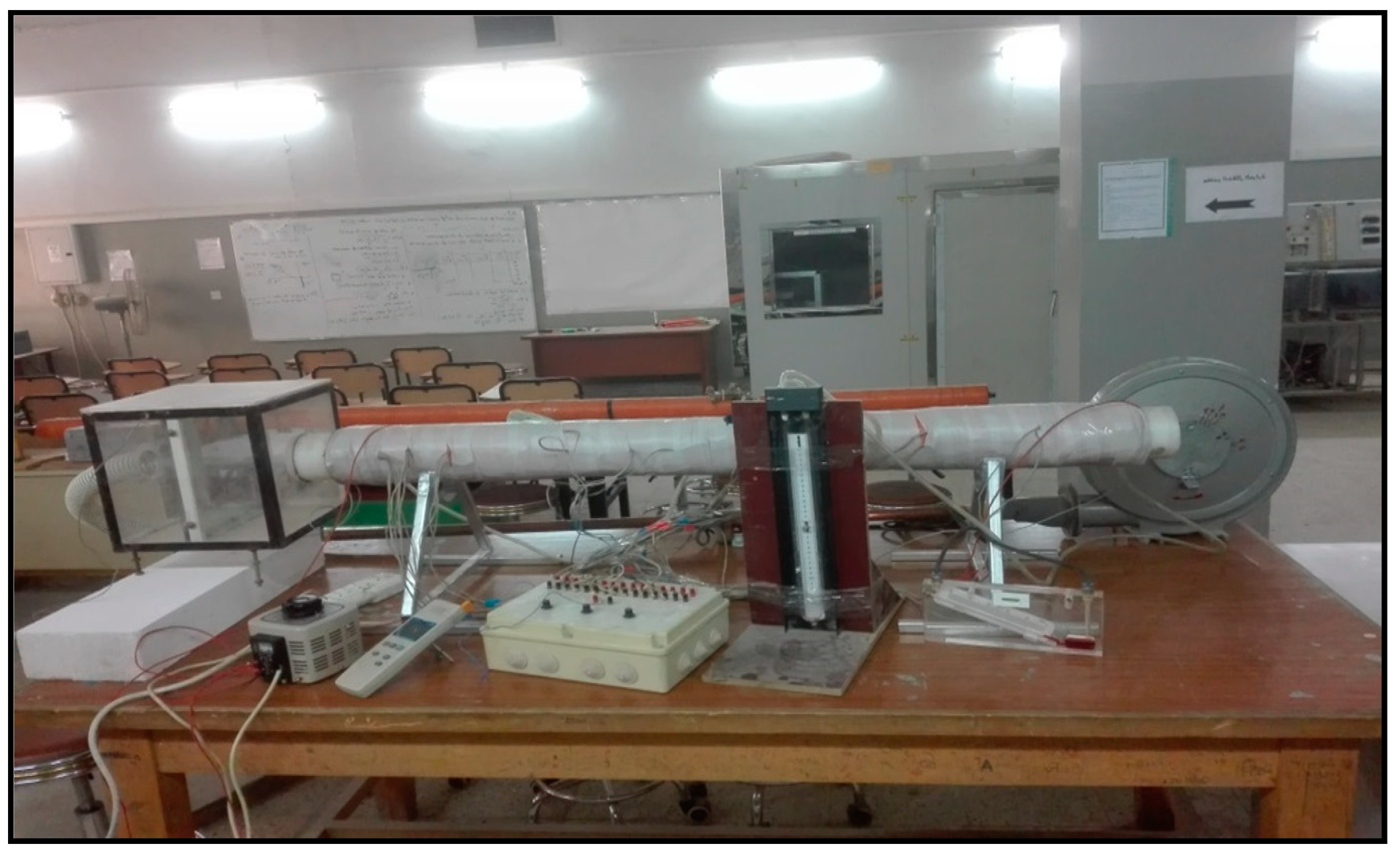
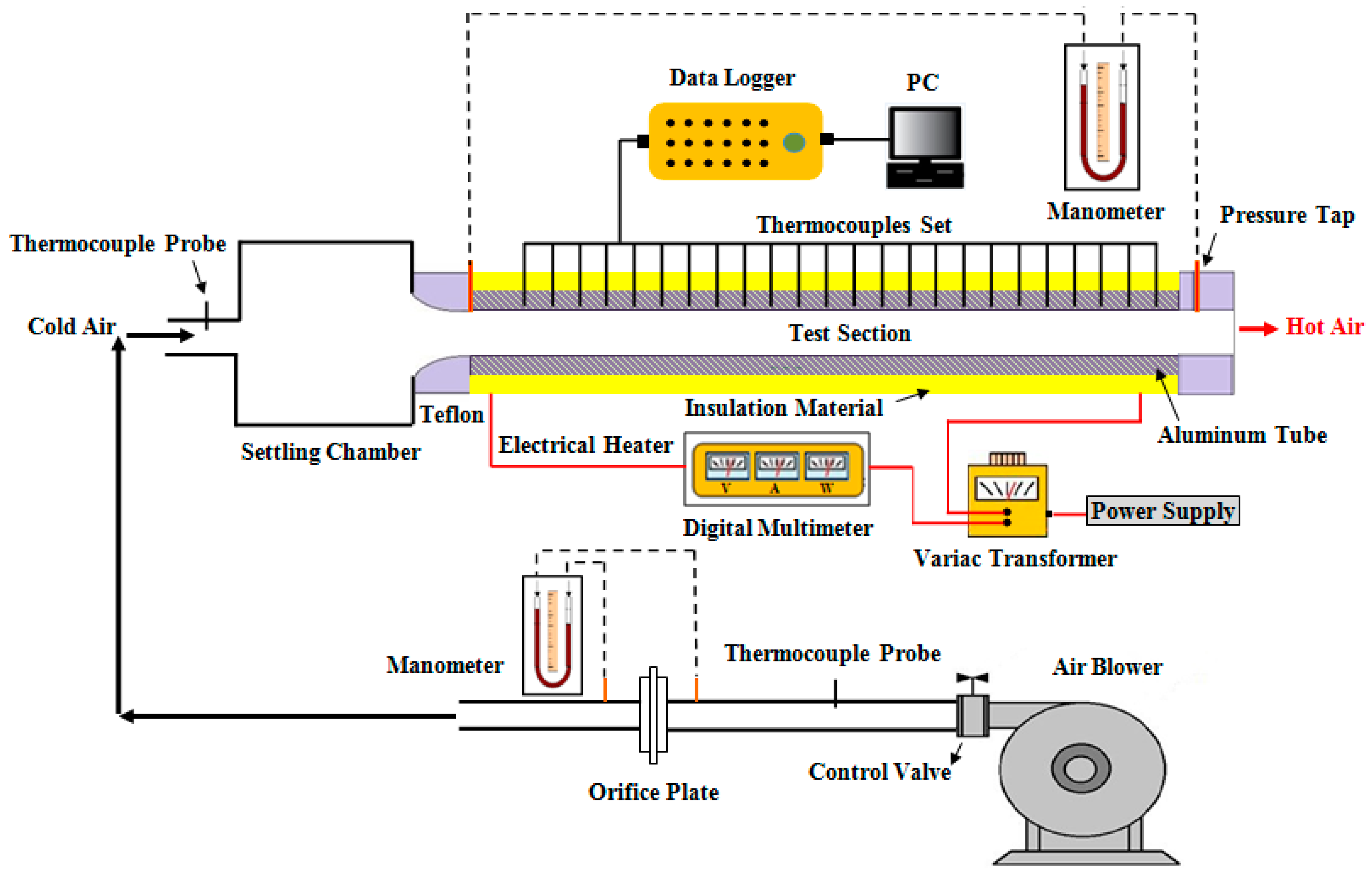
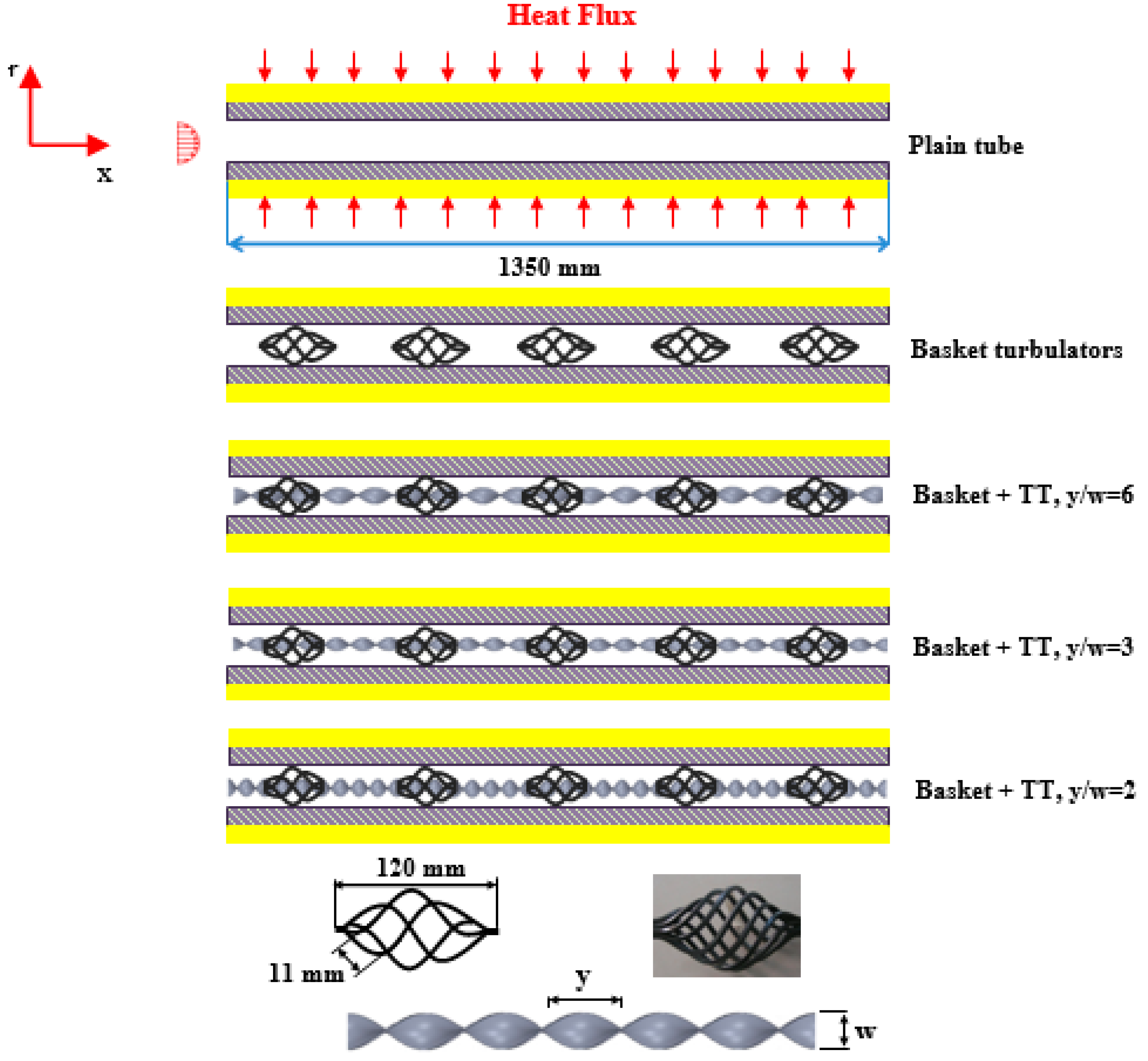

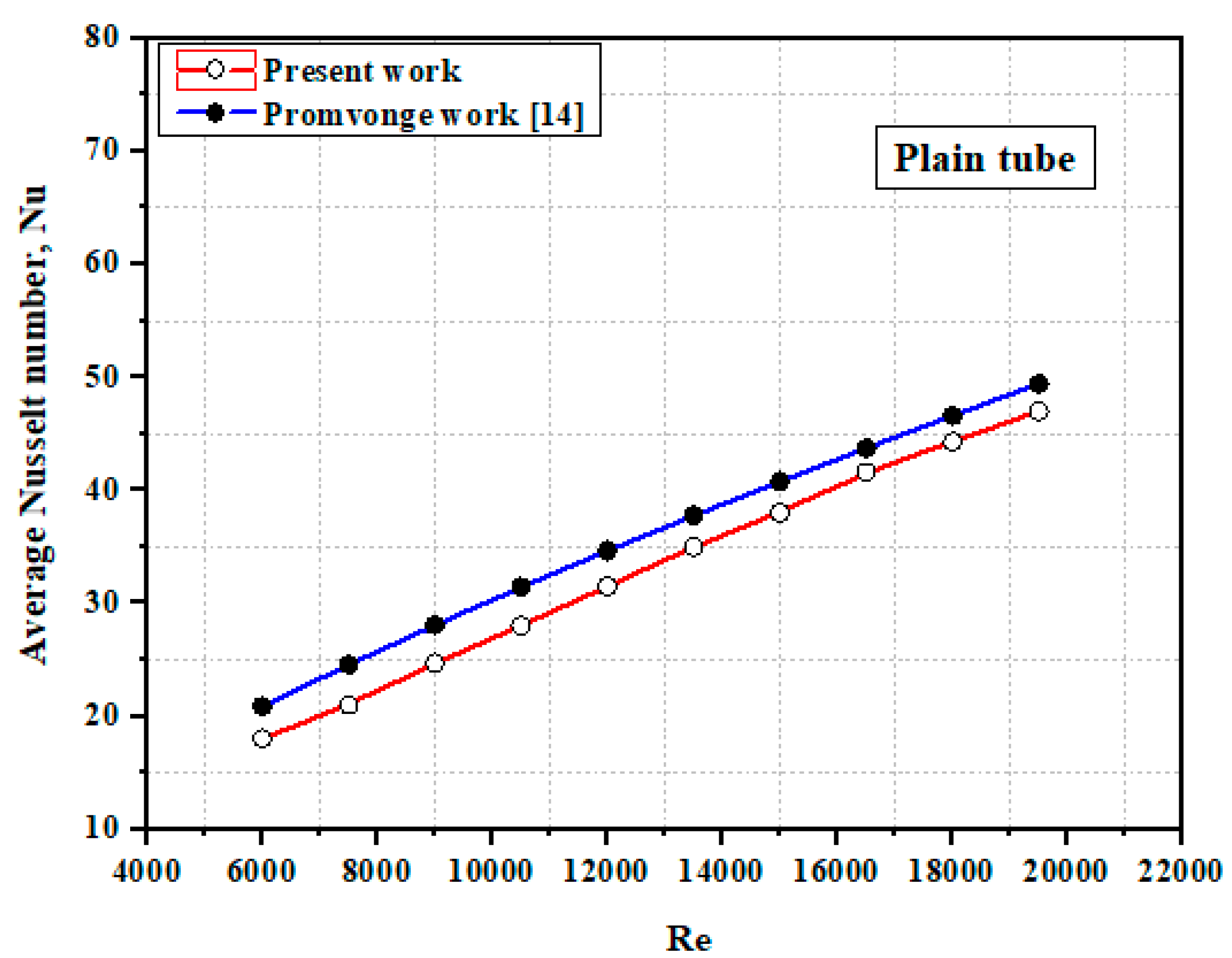
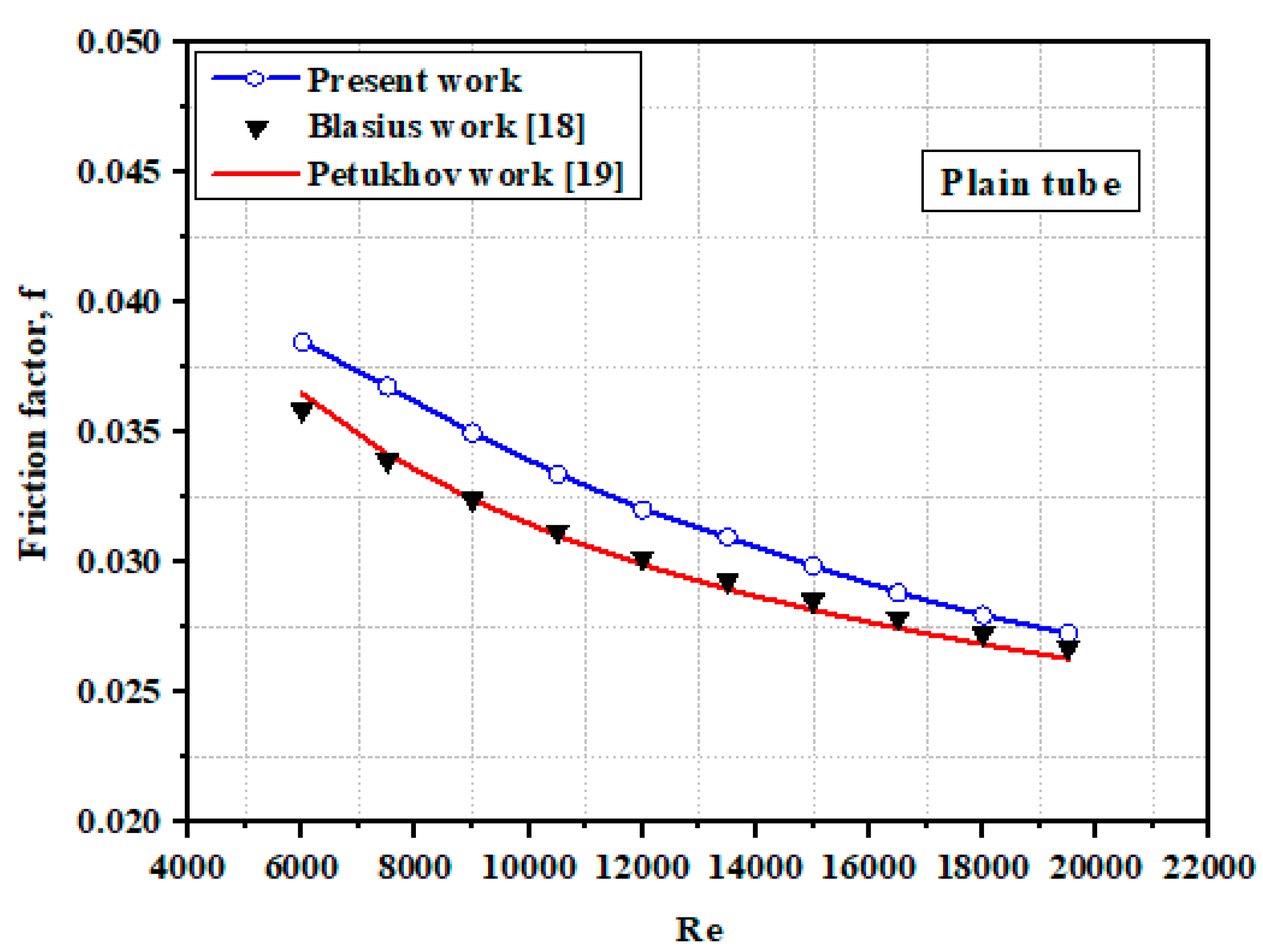

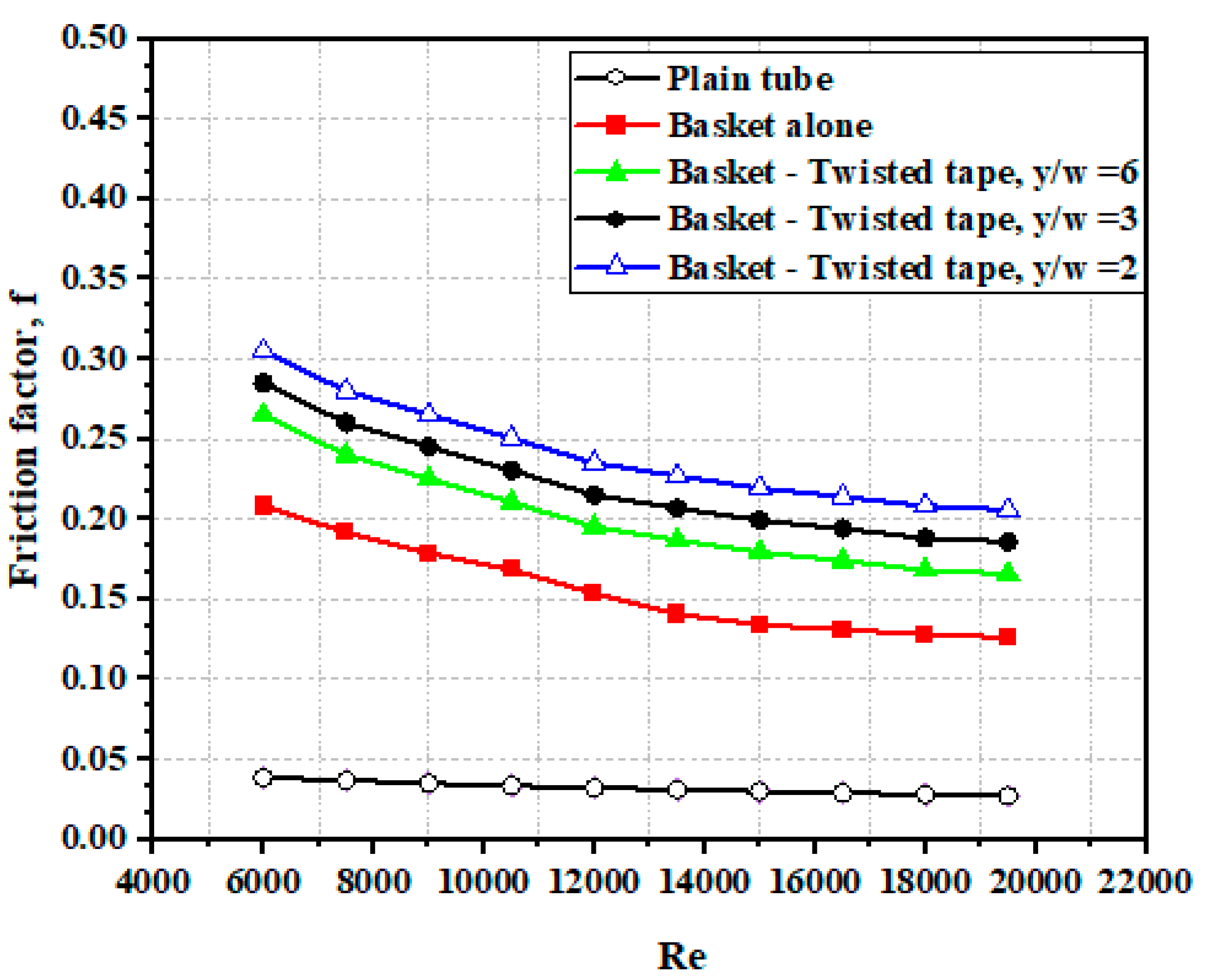
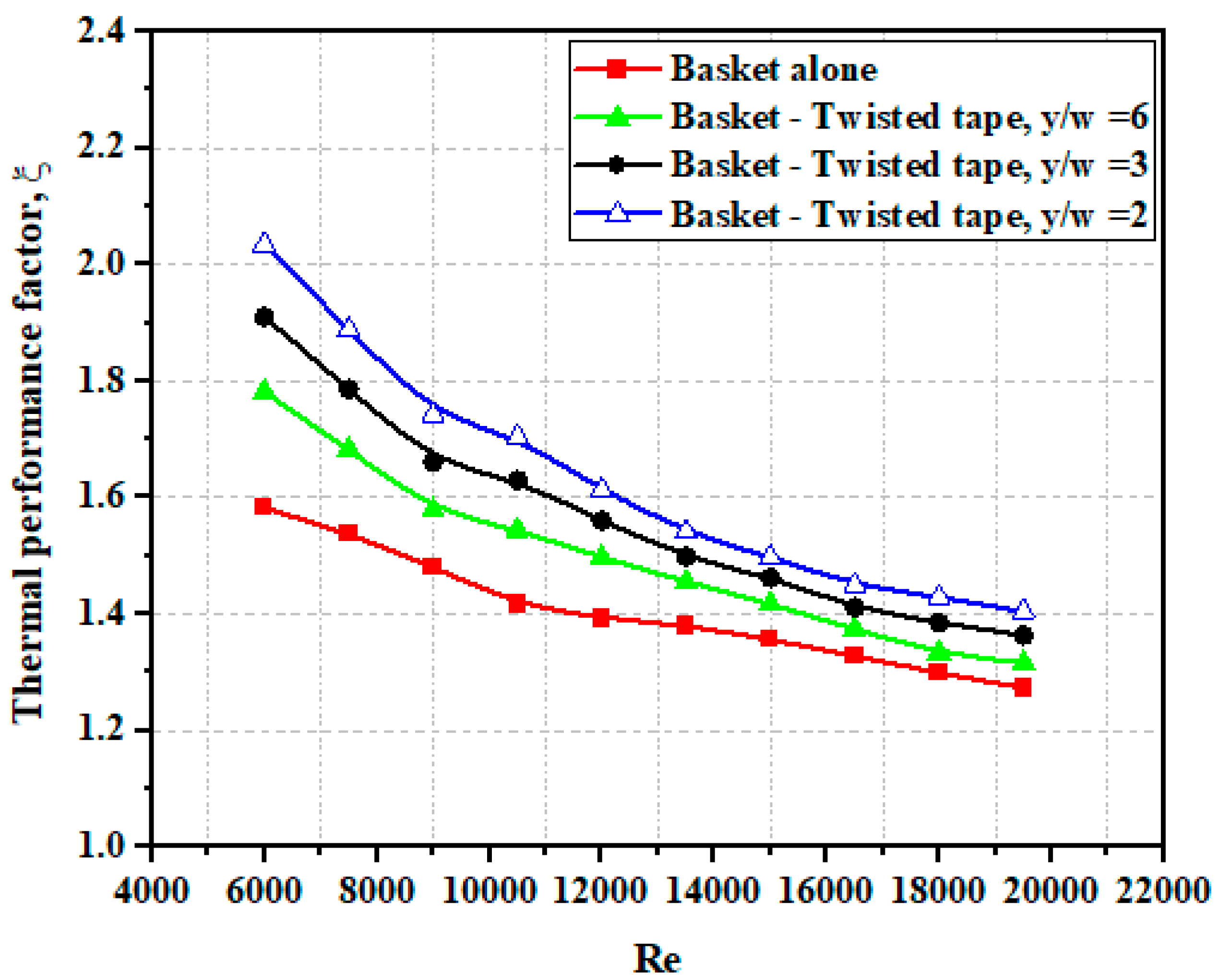


| No. | 1 | 2 | 3 | 4 | 5 | 6 | 7 | 8 | 9 | 10 | 11 | 12 | 13 | 14 | 15 | 16 | 17 | 18 |
|---|---|---|---|---|---|---|---|---|---|---|---|---|---|---|---|---|---|---|
| Position-x-(mm) | 10 | 20 | 30 | 50 | 70 | 90 | 130 | 170 | 230 | 290 | 380 | 470 | 570 | 670 | 770 | 900 | 1040 | 1180 |
| Measured Parameters | Value |
|---|---|
| Temperature | |
| Air velocity | |
| Current of the heater | |
| Voltage of the heater |
Publisher’s Note: MDPI stays neutral with regard to jurisdictional claims in published maps and institutional affiliations. |
© 2022 by the authors. Licensee MDPI, Basel, Switzerland. This article is an open access article distributed under the terms and conditions of the Creative Commons Attribution (CC BY) license (https://creativecommons.org/licenses/by/4.0/).
Share and Cite
Khafaji, H.Q.A.; Abdul Wahhab, H.A.; Alsaedi, S.S.; Al-Maliki, W.A.K.; Alobaid, F.; Epple, B. Thermal Performance Evaluation of a Tubular Heat Exchanger Fitted with Combined Basket–Twisted Tape Inserts. Appl. Sci. 2022, 12, 4807. https://doi.org/10.3390/app12104807
Khafaji HQA, Abdul Wahhab HA, Alsaedi SS, Al-Maliki WAK, Alobaid F, Epple B. Thermal Performance Evaluation of a Tubular Heat Exchanger Fitted with Combined Basket–Twisted Tape Inserts. Applied Sciences. 2022; 12(10):4807. https://doi.org/10.3390/app12104807
Chicago/Turabian StyleKhafaji, Hayder Q. A., Hasanain A. Abdul Wahhab, Sajda S. Alsaedi, Wisam Abed Kattea Al-Maliki, Falah Alobaid, and Bernd Epple. 2022. "Thermal Performance Evaluation of a Tubular Heat Exchanger Fitted with Combined Basket–Twisted Tape Inserts" Applied Sciences 12, no. 10: 4807. https://doi.org/10.3390/app12104807








